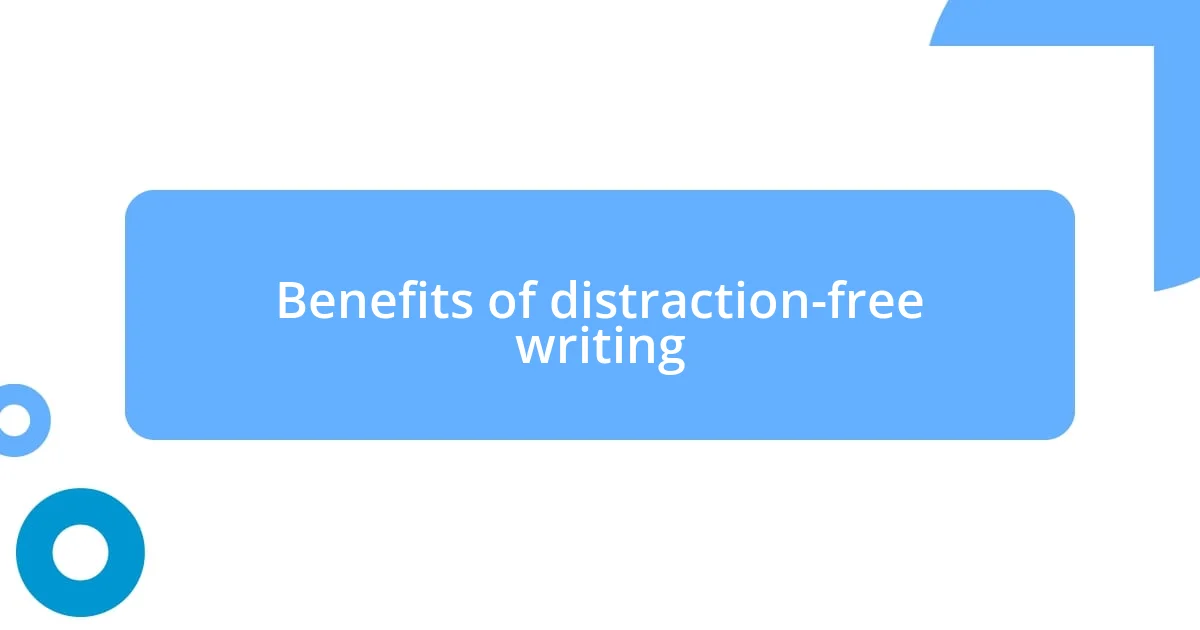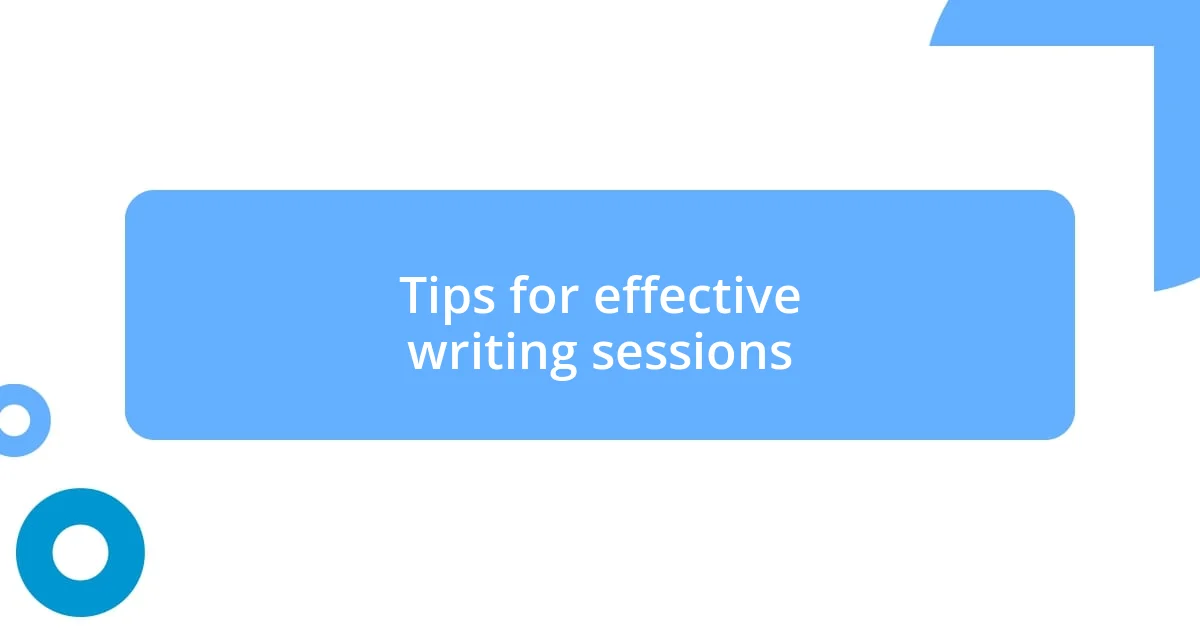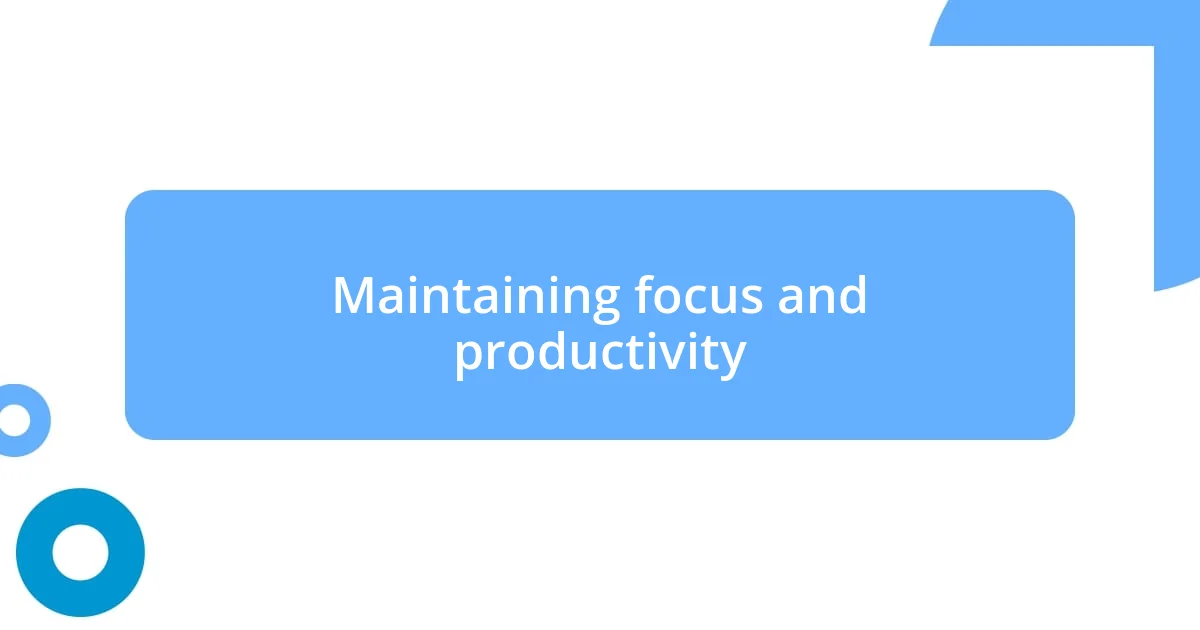Key takeaways:
- Distraction-free writing tools enhance focus and creativity by limiting visual noise and interruptions.
- Key features to look for include a clean interface, focus modes for different tasks, and cloud sync capability for accessibility.
- Effective writing sessions are facilitated by having a dedicated space, establishing a routine, and taking short breaks to recharge creativity.

Understanding distraction-free writing tools
Distraction-free writing tools are designed to create an environment conducive to focus and creativity. I remember the first time I used one—suddenly, the clutter of my desktop faded away, and it felt like a weight had lifted. Isn’t it amazing how removing visual noise can open up space for our thoughts?
These tools often feature minimalist interfaces that prevent interruptions, allowing writers to immerse themselves in their work. When I dive into a project using such a tool, I find my ideas flow more freely, as if I’ve found a secret pathway to my creativity. Have you ever experienced that exhilarating moment when words come out smoothly, and you lose track of time? I definitely have, and it’s moments like these that make me appreciate the power of distraction-free writing.
Additionally, many of these tools come with features like font customization and customizable backgrounds, which can enhance your writing experience even further. I once switched to a calming shade of blue, and it transformed my writing sessions into a soothing ritual. Reflecting on that, don’t you think the aesthetics of our writing tools can significantly impact our creativity?

Benefits of distraction-free writing
When I shifted to distraction-free writing, I noticed a remarkable boost in my focus and productivity. This approach allowed me to slip into a state of flow more easily, where ideas crystallized and my creativity thrived. I recall a day spent writing a chapter, where I was so engrossed that I lost track of time, barely noticing the hours slipping by. That sense of immersion is something I cherish profoundly.
Here are some key benefits I’ve experienced with distraction-free writing:
- Enhanced Focus: With fewer distractions, I can delve deeper into my thoughts, leading to richer content.
- Increased Productivity: I’ve found that my output doubles when I eliminate interruptions.
- Clearer Thoughts: The clarity that comes from a cleaner workspace allows for more coherent and organized writing.
- Reduced Anxiety: I feel less overwhelmed knowing my focus isn’t being pulled in multiple directions.
- Greater Creative Freedom: Without interruptions, I explore ideas more freely, resulting in unique and innovative content.

Key features to look for
When choosing a distraction-free writing tool, I highly recommend looking for a clean and intuitive interface. My experience has shown that simplicity matters; the less cluttered the screen, the easier it is to concentrate. I once tried a tool with a complicated dashboard, and it took me a full hour to get comfortable. That’s an hour I could have spent writing!
Another feature that truly enhances my writing experience is the ability to toggle between focus modes. Whether I’m drafting, editing, or brainstorming, having different modes available has revolutionized how I approach each task. I remember the first time I switched to ‘distraction-free mode’ in my tool; it felt like stepping into a serene bubble away from the chaos of notifications and alerts. This adaptability allows my writing practices to evolve seamlessly.
Lastly, I find it incredibly helpful when tools offer cloud sync capability. My writing sessions often take place in various locations, from cozy cafes to my home office. Once, I lost a significant amount of work after neglecting to back it up while writing at a coffee shop. Thankfully, cloud capability allowed me to recover my pieces and continue effortlessly from exactly where I left off, no matter where I was.
| Feature | Importance |
|---|---|
| Clean Interface | Reduces distractions and helps maintain focus |
| Focus Modes | Allows tailored environments for different writing tasks |
| Cloud Sync | Ensures access to files across multiple devices |

Top writing tools to consider
When it comes to distraction-free writing tools, I’ve personally found that Ulysses stands out for its beautiful simplicity. The moment I opened the app, I felt a sense of calm wash over me. It’s like stepping into a tranquil writer’s studio—no unnecessary buttons or complicated features to distract me. Have you ever felt that instant clarity when your environment is just right? That’s what Ulysses provides.
Another tool that I often turn to is Scrivener, which is excellent for organizing longer projects. I remember the first time I used its corkboard feature; it was like having a visual map of my thoughts. I was able to reorganize chapters and ideas with ease, making the entire process feel less overwhelming. It’s magical how such features can transform what could feel like chaos into a structured, flowing narrative. Isn’t it amazing how the right tools can make complex tasks feel effortless?
Lastly, I can’t overlook IA Writer. Its minimalistic interface draws me in every time, and I often find myself getting lost in writing sessions that last for hours. One evening, I was so engaged that I barely noticed the sunset outside—how often do we allow ourselves that kind of time and space to just create? For anyone seeking a fluid writing experience, IA Writer’s focus mode is like an invitation to block everything else out. It’s about creating that sacred space where ideas can truly blossom.

Tips for effective writing sessions
To make my writing sessions more effective, I emphasize the importance of setting a dedicated space. I remember the days when I would write in various spots around the house without much thought—it often led to distractions. Now, I always choose a cozy nook designated solely for writing. Have you ever noticed how being in a specific environment can signal your brain to shift into work mode? It truly makes a difference.
I also find that establishing a routine enhances my focus. I tend to write best in the early morning, with a cup of coffee warming my hands and the world still quiet outside. This ambiance infuses my sessions with energy, helping me dive into my creative flow. Have you tried pinning down your most productive hours? You might be surprised by how much smoother the writing process becomes.
Taking short breaks is another strategy I swear by. After about 25 minutes of focused writing, I step away, stretch, and let my mind wander. This breathing space not only recharges my creativity but often sparks new ideas. Isn’t it fascinating how stepping back can sometimes lead to breakthroughs? After all, writing is not just about pushing words onto the page; it’s about cultivating a vibrant mental garden.

Maintaining focus and productivity
Maintaining focus during writing sessions can sometimes feel like an uphill battle, but I’ve discovered certain techniques that help me tremendously. One approach that works wonders for me is turning off notifications on all my devices. I still recall a day when a text ping interrupted my train of thought, causing me to lose my flow completely. Have you ever experienced that frustrating moment when a simple notification derails your creativity? By creating a digital sanctuary, I can dive deeper into my writing without the constant pinging reminders of the outside world.
I also like to take advantage of ambient noise to maintain that sweet spot of focus. There’s something comforting about soft background music or the gentle hum of a café that enhances my concentration. I remember once writing a critical piece while the rain pattered against my window; it felt like a perfect companion to my thoughts. Doesn’t the right sound environment make a difference? This sensory approach truly amplifies my productivity, giving me just the right amount of stimulation to stay engaged in my writing.
Regularly reassessing my writing goals also plays a key role in my focus and productivity. I find that breaking down larger projects into manageable tasks helps keep the momentum going. One weekend, I set a goal to write just 300 words a day, and I was amazed at how quickly those small victories added up. It’s those little achievements that keep the motivation flowing, don’t you think? Celebrating progress, no matter how small, reminds me that each word counts in the bigger picture.














